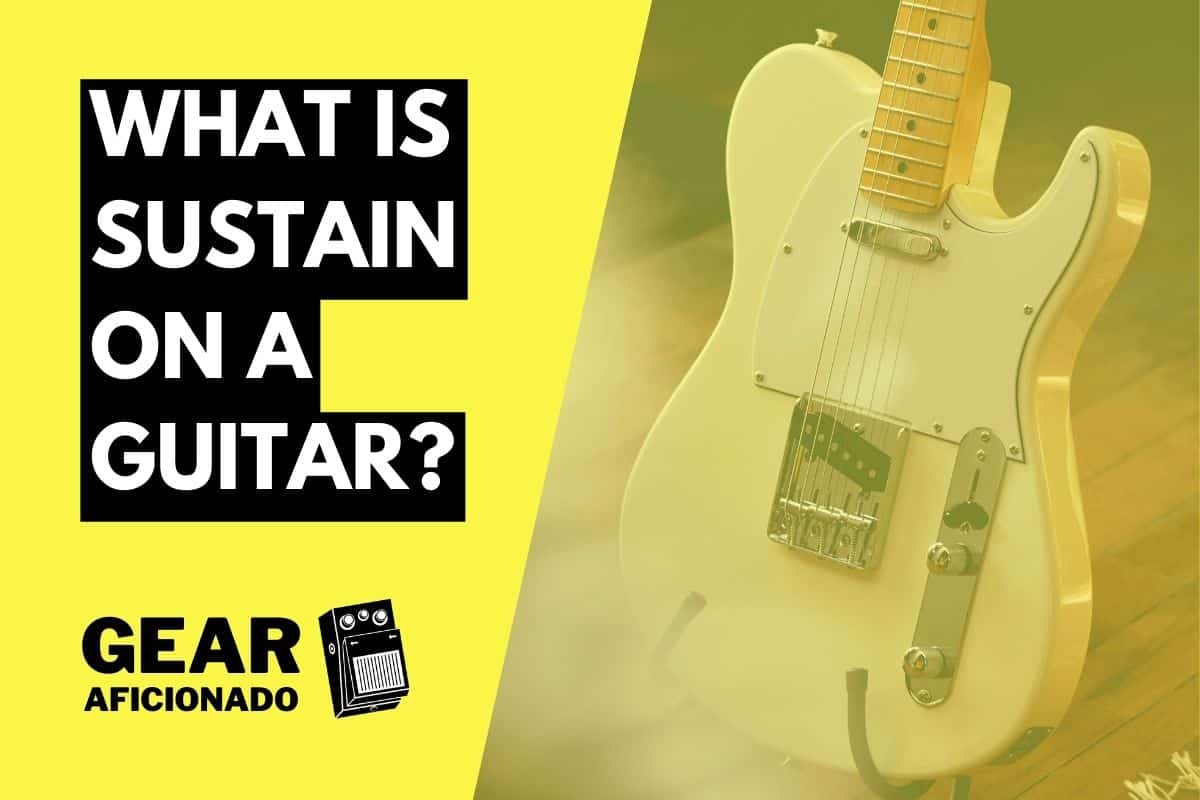Guitar playing is a symphony of strings and sound, a delightful dance between fingers and frets.
One of the most enchanting yet often misunderstood elements of this dance is ‘sustain’.
Ever noticed how some notes on some instruments seem to ring out longer, filling the air with a lingering resonance?
That’s sustain at work!
But what exactly is it, and why is it so crucial in guitar playing?
In this article, we’ll journey through the world of sustain, decoding its mysteries and revealing its role in creating music that can truly touch the soul.
You’ll learn about the science behind sustain, how it affects the sound of a guitar, and the techniques to enhance its presence in your music.
From the raw acoustic realm to the electrified echoes of electric guitars, we will explore the fascinating diversity of sustain across various guitar types.
Whether you’re a seasoned professional or a budding guitar enthusiast, understanding sustain can transform your playing and give your music a new depth.
So, prepare to fine-tune your knowledge and strike a chord with the enchanting power of sustain!
Definition of Sustain
Sustain refers to the length of time a note rings out after being plucked or strummed on a guitar.
It’s the duration during which the sound remains audible before it eventually fades away without adding more energy to the string.
The sustain of a note can be affected by a variety of factors. The type of guitar, the type of strings, the setup of the guitar, and the playing technique can all influence sustain.
Physical Factors Influencing Sustain
Several physical factors can influence the sustain of a guitar:
- Materials and Construction: The type of wood used in the guitar’s body and neck, as well as the overall quality of construction, can affect sustain. Denser woods like mahogany and maple tend to produce longer sustain, while lighter woods like basswood may have less. The joint between the neck and body also plays a role; set necks or neck-through designs often provide more sustain than bolt-on necks.
- Strings: Heavier gauge strings vibrate more and for longer, which can increase sustain. However, they require more finger strength to play.
- Setup: The guitar’s setup, including the height of the action (distance between the strings and fretboard), neck relief (slight curvature of the neck), and intonation (tuning accuracy across the fretboard), can all influence sustain. Properly adjusted, these elements can maximize sustain.
- Hardware: The type and quality of the guitar’s hardware can also affect sustain. This includes the bridge, the nut, and the tuners. Materials, design, and how well these components are fitted to the guitar can either enhance or detract from sustain.
- Fret condition: Worn or improperly installed frets can reduce sustain. Regular maintenance to ensure frets are in good condition can help maintain sustain.
- Pickups: The type and placement of pickups can impact the guitar’s sustain. Some pickups can help to extend the sustain of a note, while others might shorten it.
How the Strings, Body, and Neck of the Guitar Contribute to Sustain
The strings, body, and neck of a guitar each play a critical role in the sustain of the instrument.
Strings
The strings are where the sound originates.
When plucked or strummed, they vibrate at a specific frequency, creating sound.
Heavier strings have more mass and therefore tend to vibrate longer, leading to increased sustain.
However, they require more energy (force) to set into motion.
Material and age of the strings also matter; older, worn-out strings tend to have less sustain than new ones, and different materials can also affect the sustain.
Body
The body of the guitar serves as a resonating chamber that amplifies the vibrations of the strings.
The type of wood used and the quality of the construction can significantly affect the guitar’s sustain.
Dense woods like mahogany and maple tend to sustain notes longer because they’re more efficient at transmitting vibrations.
The design and construction of the body, including aspects such as the quality of the joint between the body and neck, can also affect sustain.
Guitars with solid bodies typically have better sustain than hollow or semi-hollow bodies because solid bodies vibrate less and thus absorb less energy from the strings.
Neck
The type of wood used for the neck, the neck’s construction, and the way it’s attached to the body all contribute to sustain.
Like the body, denser woods for the neck tend to increase sustain.
The way the neck is attached to the body is also important.
Set necks (glued into the body) and neck-through designs (where the neck extends through the entire length of the body) usually provide more sustain than bolt-on necks because they offer better vibrational transfer from the strings to the body.
The condition of the frets on the neck also matters; worn or improperly installed frets can reduce sustain.
Effect of Electric Pickups and Amplifiers on Sustain in Electric Guitars
Pickups and amplifiers are also very important for a guitar’s sustain.
Pickups
Pickups work by creating a magnetic field that picks up the vibrations of the strings and converts them into an electrical signal.
The strength of the magnetic field created by the pickups can affect sustain.
Stronger magnets can pull on the strings, dampening their vibrations and potentially reducing sustain.
Conversely, pickups with weaker magnets might not dampen the strings as much, potentially leading to longer sustain.
However, it’s not all about magnet strength.
The design of the pickup (single-coil vs. humbucker, for example) and its position relative to the strings can also impact sustain.
Also, active pickups (which have a built-in preamp) can boost the signal and thus potentially increase perceived sustain, despite the actual physical sustain of the string not being increased.
Amplifiers
Guitar amplifiers also affect sustain but in a different way.
Amplifiers work by increasing the volume of the sound signal from the pickups.
Some amplifiers, particularly tube amps, have a natural compression effect on the signal.
This compression can increase the volume of quieter sounds and decrease the volume of louder sounds.
When it comes to sustain, this means that as a note starts to fade out, the compression effect of the amplifier can boost the volume of the note, making it sound like it’s sustaining for longer.
This isn’t increasing the physical sustain of the note (i.e., how long the string is actually vibrating), but it increases the perceived sustain.
2 Types of Sustain in Guitar Playing
As I hinted before, natural sustain and artificial sustain refer to two different ways in which a guitar note can continue to sound over a period of time.
Natural Sustain
This is a property of the guitar itself, and it’s influenced by factors such as the type of wood used in the guitar’s construction, the guitar’s setup, the type of strings used, and how the instrument is played. When a guitar string is plucked or strummed, it begins to vibrate.
These vibrations produce sound, and the length of time that the sound continues is the natural sustain.
Natural sustain ends when the energy of the vibrating string dissipates to the point where it is no longer audibly producing sound.
Artificial Sustain
This type of sustain is created through electronic means, such as effects pedals or the use of certain amplifier settings.
These devices and settings manipulate the signal produced by the guitar’s pickups to maintain or even increase the volume of a note over time.
For example, a compressor pedal can level out the volume of your notes, making quiet notes louder and therefore extending the perceived duration of the sound.
Similarly, a sustain pedal or feedback from an amplifier can also create artificial sustain.
Examples of well-known songs where sustain is prominently used
Sustain and electric guitar solos come hand in hand, so picking the most emblematic examples of it is an arbitrary task, however here are 3 songs that I love that take advantage of long sustained notes:
Shine On You Crazy Diamond – Pink Floyd
David Gilmour’s guitar work in this song is a fantastic example of sustain.
His solos often let notes ring out, creating an atmospheric, expressive sound that Pink Floyd is known for.
Free Bird – Lynyrd Skynyrd
In the lengthy guitar solo towards the end of the song, sustain is used to great effect.
The long, held notes add to the emotional intensity of the solo.
Parisienne Walkways – Gary Moore
This song is a masterclass in the use of sustain.
Gary Moore’s soaring notes in the main melody and solo are held for an impressively long time, showcasing his control over the guitar’s sustain and creating a highly emotional and memorable performance.
5 Tips for Increasing the Sustain of Your Guitar
- Use Heavier Strings: Lighter strings tend to have less sustain than heavier ones. If you’re using light gauge strings, consider switching to a heavier gauge. Thicker strings vibrate more and for longer, which can increase sustain. Be aware, however, that heavier strings are harder to play and can require more finger strength.
- Adjust the Action: The action of a guitar is the distance between the strings and the fretboard. If the action is too high, it can reduce sustain. If it’s too low, you might get fret buzz. Find the sweet spot where you have good sustain without fret buzz.
- Use a Compressor Pedal: A compressor pedal can greatly increase sustain by leveling out the volume of your notes. It makes quiet notes louder and loud notes quieter, which can help notes ring out longer.
- Proper Setup and Maintenance: Make sure your guitar is properly set up. This includes proper intonation, neck relief, and action height. All these factors can influence sustain. Also, keep your guitar clean and well-maintained. Dirt and grime can decrease sustain.
- Use Sustain-Enhancing Gear: Some guitars are just naturally more resonant than others, and the same goes for amplifiers. But there are also plenty of devices designed to enhance sustain. Sustain pedals, E-bows, and even certain types of picks can all help. Additionally, using a tube amp can often provide more sustain than a solid-state amp.
Proper Technique for Increasing Sustain
While hardware and equipment certainly play a role in the sustain of a guitar, your technique also has a significant impact.
Here are some techniques that can help increase the sustain of your guitar playing:
- Picking Strength: Striking the strings with more force causes them to vibrate more vigorously, which can increase sustain. However, you have to balance this with control, as hitting the strings too hard can lead to unwanted noise and a less clear tone.
- Vibrato: Vibrato is a technique where you rapidly bend the string back and forth slightly after playing a note. This can help to maintain the energy of the string’s vibration and prolong the sustain.
- Fretting Technique: Press down on the strings firmly and cleanly right behind the frets. If you don’t fret the note firmly enough, the string can buzz against the fret and decrease sustain. If your fingers are too far from the fret, the same can happen.
- Use of Open Strings: Open strings tend to have more sustain than fretted notes. If possible, consider arranging your piece to take advantage of open strings.
- Letting Notes Ring: If you’re playing a passage with multiple notes and want to maximize sustain, try to let each note ring out as long as possible before moving to the next one. This can create a more legato, connected sound.
- Harmonics: Playing natural harmonics can also increase sustain. Because you’re not damping the string with your finger, the string can vibrate freely, leading to increased sustain.
Role of Guitar Setup and Maintenance
The action, intonation, and neck relief of a guitar are crucial elements of the instrument’s setup that can significantly affect sustain.
A carefully adjusted action and correctly set intonation and neck relief can enhance the vibrations of the strings, contributing to a better sustain.
The state of the nut and saddle is also important.
They need to be precisely cut and fitted. Improperly cut nut or saddle slots can cause string buzz or limit the string’s vibration, which reduces sustain.
Fret condition plays a substantial role too.
Worn-out or damaged frets can introduce unwanted noise or dead spots on the neck, diminishing the sustain. Regular maintenance, including fret dressing or replacement when necessary, can help keep sustain at its maximum.
Cleanliness is another often overlooked aspect.
Over time, accumulated dirt, sweat, and grime, especially on the strings and fretboard, can mute the strings’ ability to vibrate freely, thus decreasing sustain.
Regular cleaning and changing of strings can ensure your guitar’s ability to sustain notes.
Lastly, the tightness of the hardware is vital.
Loose hardware, such as tuning pegs, strap buttons, or the bridge, can absorb the string vibrations and cause a loss in sustain.
Ensuring that all hardware elements are tightly secured can significantly improve the sustain of your guitar.
A well-maintained guitar will not only offer improved sustain but will also provide a more enjoyable playing experience and extend the lifespan of the instrument.
Regular check-ups and adjustments by a professional luthier are beneficial for any serious guitarist.
Guitar Accessories That Can Enhance Sustain
There are several guitar accessories that can be used to enhance sustain:
- Compressor Pedals: Compressors work by leveling out the volume of your playing, making the quieter parts louder and the louder parts quieter. By boosting the volume of a note as it starts to fade, a compressor can increase the perceived sustain.
- Sustain Pedals: These are effects pedals specifically designed to increase sustain. They work by capturing the signal of a note and then playing it back for an extended period, effectively ‘sustaining’ the note.
- Overdrive/Distortion Pedals: These pedals can increase sustain by adding gain to your signal. The added gain causes the note to break up and distort, which can prolong the sound.
- Ebow: An Ebow is a handheld device that uses an electromagnetic field to vibrate the strings, creating infinite sustain. It’s an unusual accessory, but it can create some unique sounds.
- Brass or Graphite Nuts and Saddles: Upgrading to a denser material like brass for your nut and saddle can increase sustain. These materials are more efficient at transmitting vibrations from the strings to the body of the guitar.
- String Sustain Devices: There are also devices like the Sustainiac, an electronic gizmo similar in function to an ebow, but fixed to a pickup, or the Fatfinger, which attaches to the headstock or body of the guitar to add mass, which can enhance sustain.
- Quality Strings: Higher quality strings often provide better sustain. Coated strings, in particular, are known for their longer sustain and overall longevity.
Differences in Sustain Between Acoustic and Electric Guitars
Acoustic guitars use the resonance of the guitar’s body to amplify the sound of the strings.
The sustain on an acoustic guitar is typically less than on an electric guitar.
This is because the energy of the string vibration is more quickly transferred into sound via the guitar’s top, or soundboard, and this energy quickly radiates away as sound into the air.
The type of wood, the shape and size of the body, and the guitar’s overall construction can all impact the level of sustain an acoustic guitar can produce.
Electric guitars, on the other hand, rely on electromagnetic pickups to capture the vibration of the strings and convert it into an electrical signal, which is then amplified.
Because the sound doesn’t depend on the resonance of the guitar’s body in the same way, electric guitars typically have greater sustain than acoustic guitars.
The solid body of an electric guitar doesn’t absorb as much of the string vibration energy as the hollow body of an acoustic guitar, allowing the strings to vibrate for a longer period of time.
Furthermore, with the use of electric guitar amplifiers and effects, the sustain can be significantly extended.
It’s important to note that while these are general principles, the exact amount of sustain can vary significantly from one guitar to another, even within the same category of acoustic or electric because of factors such as the ones listed below.
How Different Guitar Builds and Materials Affect Sustain
The construction and material of a guitar significantly influence its sustain. Here’s how:
- Body Type: Solid-body guitars typically offer the best sustain because they are more efficient at transferring the vibrations of the strings into audible sound. Semi-hollow and hollow-body guitars can also have good sustain, but they are more prone to feedback, which can interfere with sustain.
- Wood Type: The type of wood used in the guitar’s body, neck, and fretboard can have a substantial effect on sustain. Denser woods like mahogany, maple, and rosewood generally provide better sustain than lighter woods because they’re more effective at transmitting vibrations. However, the exact impact can vary depending on other factors like the guitar’s design and construction.
- Neck Construction: The way the neck is attached to the body can affect sustain. Set necks (where the neck is glued to the body) and neck-through designs (where the neck extends through the entire body) tend to offer better sustain than bolt-on necks because they provide better vibrational continuity from the strings to the body.
- Bridge Type: The type of bridge can also affect sustain. Bridges that have more contact with the body of the guitar, like a Tune-o-Matic bridge, can increase sustain because they transfer vibrations to the body more effectively. On the other hand, floating bridge designs, like those used for tremolo systems, might reduce sustain because they have less contact with the body.
- Fret Material: The material of the frets can also play a role in sustain. Frets made from harder materials (like stainless steel) can potentially provide more sustain than those made from softer materials (like nickel).
- Nut and Saddle Material: Similarly, denser materials for the nut and saddle (like bone, brass, or synthetic materials like Tusq) can enhance sustain compared to softer materials (like plastic), as they are better at transmitting string vibrations.
Conclusion
Sustain, the duration a guitar note remains audible is crucial to a guitar’s sound and is influenced by numerous factors.
These include the guitar’s construction and materials, the player’s technique, and the use of external equipment.
The body type, wood, neck construction, bridge type, fret material, and quality of the nut and saddle all play roles in the guitar’s sustain.
Techniques like strong string striking, vibrato, and optimal fretting can enhance sustain.
Additionally, the guitar’s setup, maintenance, and use of specific pickups and amplifiers impact sustain.
Acoustic and electric guitars have different sustain characteristics due to their unique construction.
Finally, various accessories like pedals and sustain-enhancing devices can further influence sustain.
Achieving ideal sustain involves understanding and manipulating these factors for a more expressive sound.

Hello there, my name is Ramiro and I’ve been playing guitar for almost 20 years. I’m obsessed with everything gear-related and I thought it might be worth sharing it. From guitars, pedals, amps, and synths to studio gear and production tips, I hope you find what I post here useful, and I’ll try my best to keep it entertaining also.





